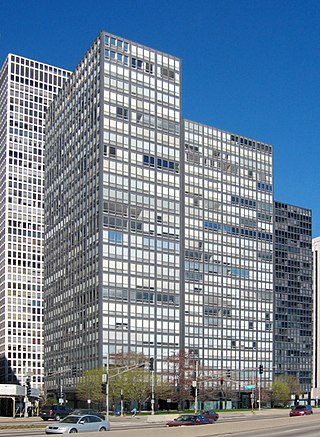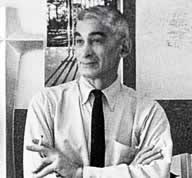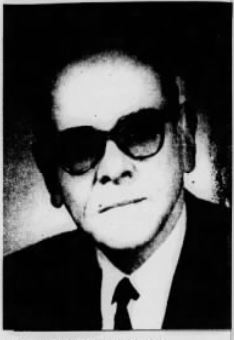
Arvonia is an unincorporated community in Buckingham County, Virginia founded mainly by Welsh immigrants during the 19th century. The town derives its name from the county of Caernarfon, Wales. The county is known popularly simply as Arfon. "Arvonia" is the Latin form of the name. Its major industry has been slate mining. The slate is known primarily for its color and durability, and is featured on many prominent American buildings, such as the Smithsonian Castle, and the University of Virginia. In 1885 Arvon Presbyterian Church was founded to serve the many Welsh miners in the Slate Quarry. The sanctuary portion of the church was destroyed by fire in 2009 and after being rebuilt to its original design, it reopened on Palm Sunday, April 12, 2012.

Buckingham is a census-designated place in and the county seat of Buckingham County, Virginia, United States. The population as of the 2010 Census was 133.

860–880 Lake Shore Drive is a twin pair of glass-and-steel apartment towers on N. Lake Shore Drive along Lake Michigan in the Streeterville neighborhood of Chicago, Illinois. Construction began in 1949 and the project was completed in 1951. The towers were added to the National Register of Historic Places on August 28, 1980, and were designated as Chicago Landmarks on June 10, 1996. The 26-floor, 254-ft tall towers were designed by the architect Ludwig Mies van der Rohe, and dubbed the "Glass House" apartments. Construction was by the Chicago real estate developer Herbert Greenwald, and the Sumner S. Sollitt Company. The design principles were copied extensively and are now considered characteristic of the modern International Style as well as essential for the development of modern high-tech architecture.

Charles M. Goodman was an American architect who made a name for his modern designs in suburban Washington, D.C. after World War II. While his work has a regional feel, he ignored the colonial revival look so popular in Virginia. Goodman was quoted in the 1968 survey book Architecture in Virginia as saying that he aimed to "get away from straight historical reproduction."

Wyandotte High School is a fully accredited public high school located in Kansas City, Kansas, United States. It serves students in grades 9 to 12 and operated by the Kansas City USD 500 school district. The building itself is a historic and notable public building, which was listed on the National Register of Historic Places in 1986. The school principal is Mary Stewart. The mascot is the Bulldog and the school colors are red and white.
Thomas Wilson Williamson was a Kansas architect who specialized in designing school buildings in Kansas, Iowa, and Missouri.

The Laura Gale House, also known as the Mrs. Thomas H. Gale House, is a home in the Chicago suburb of Oak Park, Illinois, United States. The house was designed by master architect Frank Lloyd Wright and built in 1909. It is located within the boundaries of the Frank Lloyd Wright-Prairie School of Architecture Historic District and has been listed on the U.S. National Register of Historic Places since March 5, 1970.

Clarence Wesley "Cap" Wigington (1883-1967) was an American architect who grew up in Omaha, Nebraska. After winning three first prizes in charcoal, pencil, and pen and ink at an art competition during the Trans-Mississippi Exposition in 1899, Wigington went on to become a renowned architect across the Midwestern United States, at a time when African-American architects were few. Wigington was the nation's first black municipal architect, serving 34 years as senior designer for the City of Saint Paul, Minnesota's architectural office when the city had an ambitious building program. Sixty of his buildings still stand in St. Paul, with several recognized on the National Register of Historic Places. Wigington's architectural legacy is one of the most significant bodies of work by an African-American architect.

Mary Rockwell Hook was an American architect and a pioneer for women in architecture. She worked principally from Kansas City, Missouri but designed throughout the United States. She was denied admission to the American Institute of Architects (AIA) due to her gender.
Jarvis Hunt was a Chicago architect who designed a wide array of buildings, including railroad stations, suburban estates, industrial buildings, clubhouses and other structures.

Edward Townsend Mix was an American architect of the Gilded Age who designed many buildings in the Midwestern United States. His career was centered in Milwaukee, Wisconsin, and many of his designs made use of the region's distinctive Cream City brick.

Mineral Hall in Kansas City, Missouri is a historic building constructed in 1903. An elaborate example of Prairie School architecture by Louis Singleton Curtiss, it originally served as a residence.

The Palace Clothing Company Building in Kansas City, Missouri is a building constructed in 1924. It was listed on the National Register of Historic Places in 1985.
George Putnam Washburn was a prominent architect practicing in Kansas. Washburn came to Kansas in 1870, worked as a carpenter and architect, and in 1882 opened an architecture practice in Ottawa, Kansas. His son joined his firm which became George P. Washburn & Son. In 1910 George P.'s son-in-law, Roy Stookey, joined the firm, and George P. retired. After George P. died in 1922 the firm became Washburn & Stookey.
Charles Ashley Smith, was an American architect who worked mainly in Kansas City, Missouri.
Nelle Elizabeth Nichols Peters (1884–1974) was one of Kansas City's most prolific architects.

The Protection High School, located at 210 S. Jefferson in Protection, Kansas, was built in 1930. It was designed by architects Routledge & Hertz in Late Gothic Revival style. An extension to add a grade school in 1950 was designed by Hibbs & Robinson. It has also been known as South Central Middle School and Elementary as the two schools operated by Comanche County USD 300 occupy the building. It was listed on the National Register of Historic Places in 2005.

The Kansas City, Kansas High School Gymnasium and Laboratory, at 1017 N. 9th St. in Kansas City, Kansas, was built in 1923. It was listed on the National Register of Historic Places in 2012.

Boillot and Lauck was a long term architectural partnership between Elmer R. Boillot and Jesse F. Lauck in Kansas City, Missouri. Their work includes properties listed on the National Register of Historic Places.

Leon Bishop Senter was an American architect who worked primarily in Oklahoma. Although not formally educated in architecture, he became Oklahoma's first licensed architect in 1925 and designed several buildings on the National Register of Historic Places.

















